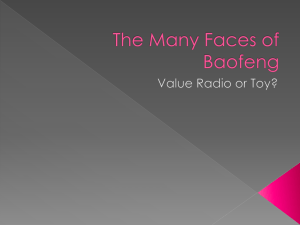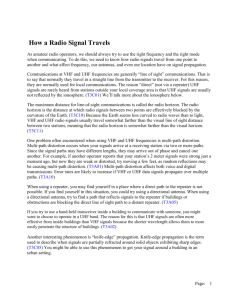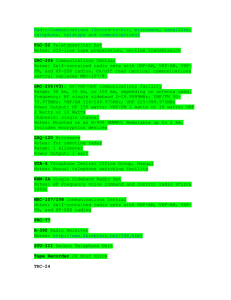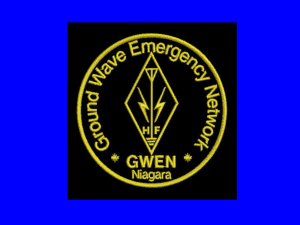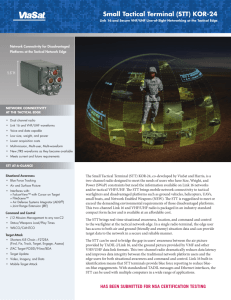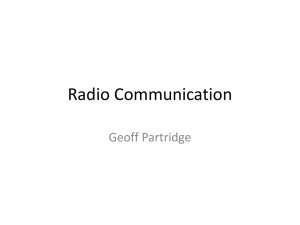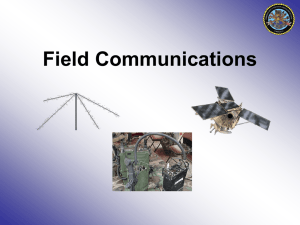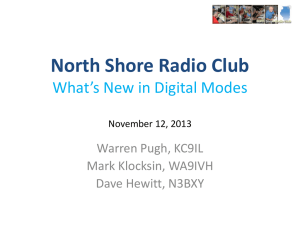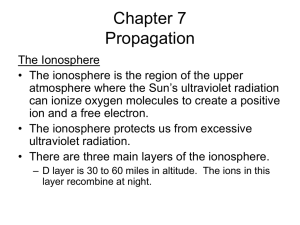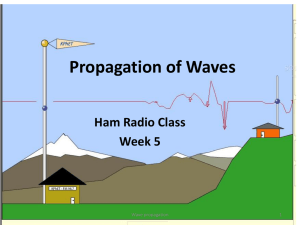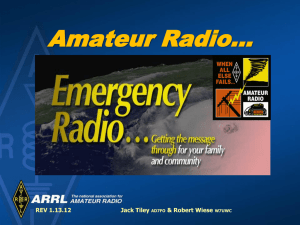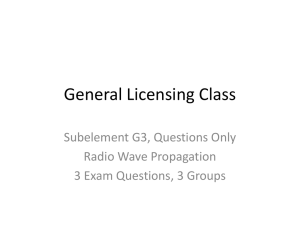Module 8 -Radio Signal Propagation C4
advertisement
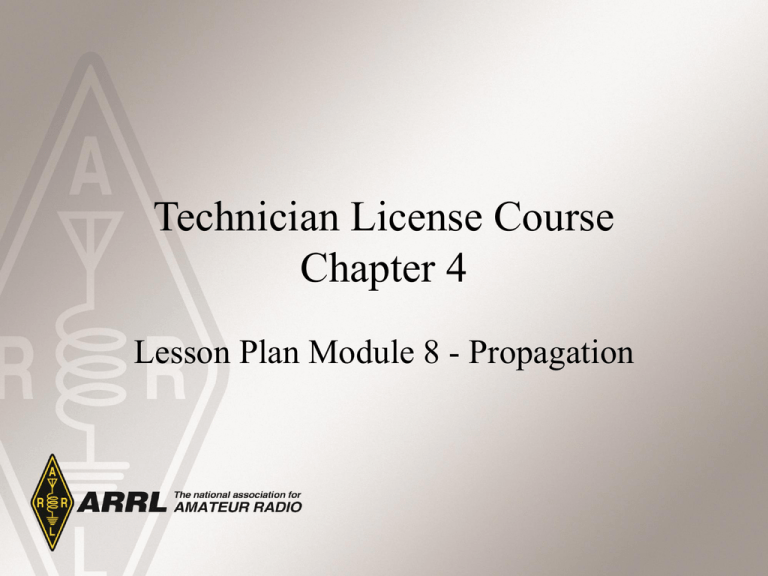
Technician License Course Chapter 4 Lesson Plan Module 8 - Propagation Radio Wave Propagation: Getting from Point A to Point B • Radio waves propagate by many mechanisms. – The science of wave propagation has many facets. • We will discuss three basic ways: – Line of sight – Ground wave – Sky wave Line-of-Sight • If a source of radio energy can been seen by the receiver, then the radio energy will travel in a straight line from transmitter to receiver. – There is some attenuation of the signal as the radio wave travels • This is the primary propagation mode for VHF and UHF signals. Ground Wave • Some radio frequency ranges (VLF, LF, MF and lower HF frequencies) will hug the earth’s surface as they travel. • These waves will travel beyond the range of line-of-sight. • A few hundred miles for HF. VHF and UHF Propagation • VHF & UHF propagation is principally line of sight. • Range is slightly better (15%) than visual line of sight. • UHF signals may work better inside buildings because of the shorter wavelength. • Buildings may block line of sight, but reflections may help get past obstructions. VHF and UHF Propagation • Reflections from a transmitter that is moving cause multi-path which results in rapid fading of signal – known as picket fencing. • Atmospheric inversions can cause VHF and UHF signals to travel long distances. This is known as tropospheric ducting. • UHF signals are normally not reflected by the ionosphere. VHF and UHF Propagation Sunspot Cycle • The level of atmospheric ionization depends on the radiation intensity of the Sun. • Radiation from the Sun is connected to the number of sunspots on the Sun’s surface. – High number of sunspots, high ionizing (UV) radiation emitted from the Sun. • Sunspot activity follows an 11-year cycle. Ionosphere • UV radiation from the Sun momentarily will strip electrons away from the parent atom in the upper reaches of the atmosphere. – Creates ions • The region where ionization occurs is called the ionosphere. Levels of the Ionosphere • Density of the atmosphere affects: – The intensity of the radiation that can penetrate to that level. – The amount of ionization that occurs. – How quickly the electrons recombine with the nucleus. Ionospheric Layers • The D layer mostly absorbs radio signals, and is not favorable to communications. Fades at night • The E layer may provide sporadic medium distance communications for HF and lower frequency VHF radio signals. • Most long distance HF communications are through the F layers. The F1 and F2 layers form during the day. At night they recombine into a single layer. The Ionosphere – An RF Mirror • The ionized layers of the atmosphere actually act as an RF mirror or prism that reflect certain frequencies back to earth. • Sky-wave propagation is responsible for most long-range, over the horizon communication. • Reflection depends on ionization level, signal frequency and angle of incidence. What should you do if another operator reports that your station’s 2 meter signals were strong just a moment ago, but now they are weak or distorted? (T3A01) • A. Change the batteries in your radio to a different type • B. Turn on the CTCSS tone • C. Ask the other operator to adjust his squelch control • D. Try moving a few feet, as random reflections may be causing multi-path distortion What should you do if another operator reports that your station’s 2 meter signals were strong just a moment ago, but now they are weak or distorted? (T3A01) • A. Change the batteries in your radio to a different type • B. Turn on the CTCSS tone • C. Ask the other operator to adjust his squelch control • D. Try moving a few feet, as random reflections may be causing multi-path distortion Why are UHF signals often more effective from inside buildings than VHF signals. (T3A02) • A. VHF signals lose power faster over distance • B. The shorter wavelength allows them to more easily penetrate the structure of buildings • C. This is incorrect: VHF works better than UHF inside buildings • D. UHF antennas are more efficient than VHF antennas Why are UHF signals often more effective from inside buildings than VHF signals. (T3A02) • A. VHF signals lose power faster over distance • B. The shorter wavelength allows them to more easily penetrate the structure of buildings • C. This is incorrect: VHF works better than UHF inside buildings • D. UHF antennas are more efficient than VHF antennas What term is commonly used to describe the rapid fluttering sound sometimes heard from mobile stations that are moving while transmitting? (T3A06) • • • • A. B. C. D. Flip-flopping Picket fencing Frequency shifting Pulsing What term is commonly used to describe the rapid fluttering sound sometimes heard from mobile stations that are moving while transmitting? (T3A06) • • • • A. B. C. D. Flip-flopping Picket fencing Frequency shifting Pulsing What is the cause of irregular fading of signals from distant stations during times of generally good reception? (T3A08) • A. Absorption of signals by the “D” layer of the ionosphere • B. Absorption of signals by the “E” layer of the ionosphere • C. Random combining of signals arriving via different path lengths • D. Intermodulation distortion in the local receiver What is the cause of irregular fading of signals from distant stations during times of generally good reception? (T3A08) • A. Absorption of signals by the “D” layer of the ionosphere • B. Absorption of signals by the “E” layer of the ionosphere • C. Random combining of signals arriving via different path lengths • D. Intermodulation distortion in the local receiver What may occur if VHF or UHF data signals propagate over multiple paths? (T3A10) • A. Transmission rates can be increased by a factor equal to the number of separate paths observed • B. Transmission rates must be decreased by a factor equal to the number of separate paths observed • C. No significant changes will occur if the signals are transmitting using FM • D. Error rates are likely to increase What may occur if VHF or UHF data signals propagate over multiple paths? (T3A10) • A. Transmission rates can be increased by a factor equal to the number of separate paths observed • B. Transmission rates must be decreased by a factor equal to the number of separate paths observed • C. No significant changes will occur if the signals are transmitting using FM • D. Error rates are likely to increase Which part of the atmosphere enables the propagation of radio signals around the world? (T3A11) • • • • A. B. C. D. The stratosphere The troposphere The ionosphere The magnetosphere Which part of the atmosphere enables the propagation of radio signals around the world? (T3A11) • • • • A. B. C. D. The stratosphere The troposphere The ionosphere The magnetosphere Why are “direct” (not via a repeater) UHF signals rarely heard from stations outside your local coverage area? (T3C01) • A. They are too weak to go very far • B. FCC regulations prohibit them from going more than 50 miles • C. UHF signals are usually not reflected by the ionosphere • D. They collide with trees and shrubbery and fade out Why are “direct” (not via a repeater) UHF signals rarely heard from stations outside your local coverage area? (T3C01) • A. They are too weak to go very far • B. FCC regulations prohibit them from going more than 50 miles • C. UHF signals are usually not reflected by the ionosphere • D. They collide with trees and shrubbery and fade out Which of the following might be happening when VHF signals are being received from long distances? (T3C02) • A. Signals are being reflected from outer space • B. Signals are arriving by sub-surface ducting • C. Signals are being reflected by lightning storms in your area • D. Signals are being refracted from a sporadic E layer Which of the following might be happening when VHF signals are being received from long distances? (T3C02) • A. Signals are being reflected from outer space • B. Signals are arriving by sub-surface ducting • C. Signals are being reflected by lightning storms in your area • D. Signals are being refracted from a sporadic E layer What is a characteristic of VHF signals received via auroral reflection? (T3C03) • A. Signals from distances of 10,000 or more miles are common • B. The signals exhibit rapid fluctuations of strength and often sound distorted • C. These types of signals occur only during winter nighttime hours • D. These types of signals are generally strongest when your antenna is aimed to the south (for stations in the Northern Hemisphere) What is a characteristic of VHF signals received via auroral reflection? (T3C03) • A. Signals from distances of 10,000 or more miles are common • B. The signals exhibit rapid fluctuations of strength and often sound distorted • C. These types of signals occur only during winter nighttime hours • D. These types of signals are generally strongest when your antenna is aimed to the south (for stations in the Northern Hemisphere) Which of the following propagation types is most commonly associated with occasional strong over-the-horizon signals on the 10, 6, and 2 meter bands? (T3C04) • • • • A. B. C. D. Backscatter Sporadic E D layer absorption Gray-line propagation Which of the following propagation types is most commonly associated with occasional strong over-the-horizon signals on the 10, 6, and 2 meter bands? (T3C04) • • • • A. B. C. D. Backscatter Sporadic E D layer absorption Gray-line propagation What is meant by the term “knife-edge” propagation? (T3C05) • A. Signals are reflected back toward the originating station at acute angles • B. Signals are sliced into several discrete beams and arrive via different paths • C. Signals are partially refracted around solid objects exhibiting sharp edges • D. Signals are propagated close to the band edge exhibiting a sharp cutoff What is meant by the term “knife-edge” propagation? (T3C05) • A. Signals are reflected back toward the originating station at acute angles • B. Signals are sliced into several discrete beams and arrive via different paths • C. Signals are partially refracted around solid objects exhibiting sharp edges • D. Signals are propagated close to the band edge exhibiting a sharp cutoff What mode is responsible for allowing overthe-horizon VHF and UHF communications to ranges of approximately 300 miles on a regular basis? (T3C06) • • • • A. B. C. D. Tropospheric scatter D layer refraction F2 layer refraction Faraday rotation What mode is responsible for allowing overthe-horizon VHF and UHF communications to ranges of approximately 300 miles on a regular basis? (T3C06) • • • • A. B. C. D. Tropospheric scatter D layer refraction F2 layer refraction Faraday rotation What band is best suited to communicating via meteor scatter? (T3C07) • • • • A. B. C. D. 10 meters 6 meters 2 meters 70 cm What band is best suited to communicating via meteor scatter? (T3C07) • • • • A. B. C. D. 10 meters 6 meters 2 meters 70 cm What causes “tropospheric ducting?” (T3C08) • A. Discharges of lightning during electrical storms • B. Sunspots and solar flares • C. Updrafts from hurricanes and tornados • D. Temperature inversions in the atmosphere What causes “tropospheric ducting?” (T3C08) • A. Discharges of lightning during electrical storms • B. Sunspots and solar flares • C. Updrafts from hurricanes and tornados • D. Temperature inversions in the atmosphere What is generally the best time for longdistance 10 meter band propagation? (T3C09) • • • • A. B. C. D. During daylight hours During nighttime hours When there are coronal mass ejections Whenever the solar flux is low What is generally the best time for longdistance 10 meter band propagation? (T3C09) • • • • A. B. C. D. During daylight hours During nighttime hours When there are coronal mass ejections Whenever the solar flux is low What is the radio horizon? (T3C10) • A. The distance at which radio signals between two points are effectively blocked by the curvature of the earth • B. The distance from the ground to a horizontally mounted antenna • C. The farthest point you can see when standing at the base of your antenna tower • D. The shortest distance between two points on the Earth’s surface What is the radio horizon? (T3C10) • A. The distance at which radio signals between two points are effectively blocked by the curvature of the earth • B. The distance from the ground to a horizontally mounted antenna • C. The farthest point you can see when standing at the base of your antenna tower • D. The shortest distance between two points on the Earth’s surface Why do VHF and UHF radio signals usually travel somewhat farther than the visual line of sight distance between two stations? (T3C11) • A. Radio signals move somewhat faster than the speed of light • B. Radio waves are not blocked by dust particles • C. The Earth seems less curved to radio waves than to light • D. Radio waves are blocked by dust particles Why do VHF and UHF radio signals usually travel somewhat farther than the visual line of sight distance between two stations? (T3C11) • A. Radio signals move somewhat faster than the speed of light • B. Radio waves are not blocked by dust particles • C. The Earth seems less curved to radio waves than to light • D. Radio waves are blocked by dust particles
